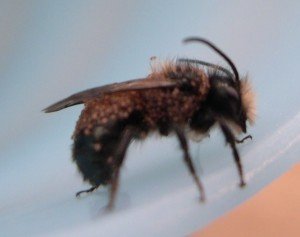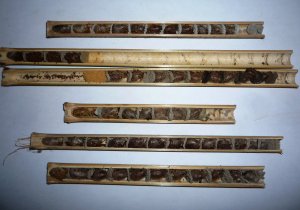Controlling Pollen Mites
for Healthy Bees
If you are reading this page on pollen mites, you are either interested in raising mason bees or already involved in raising them. These specific mites are a natural pest of the Osima family of bees. Either way, this is an important section to read if you want consistently healthy bees year after year.
So, let's jump right in. Every living thing has pests that cause irritation or harm and bees are no different. Some pests of mason bees are more of a nuisance, while others are serious threats. Pollen mites can be both.
Note: Pollen mites are more of a problem in high moisture or high humid regions. High desert areas may not experience many problems with pollen mites.
Pollen Mites

Pollen mites are very tiny, but most can be seen easily with a hand-held magnifier and are less than half a milimeter wide. The mites that plague the Osmia family of bees are called Chaetodactylus krombeini or the Hairy-Footed Mite. (Not the same mites that are decimating honeybee populations.)
The photo shows pollen mites covering the back of a mason bee. (Photo by Dave Hunter, Crownbees)
These mites do little harm to the adult bees, but are believed by many researchers to kill the eggs inside the nests.
The most serious accumulation of mites occur while bees crawl through mite infested cells when exiting the nest, which is probably what happened to the bee above. They can also pick up mites while gathering pollen when bees come into contact with other mason bees.
As the female bee stacks pollen inside the cell some of the mites drop off and hides within the pollen. Once the bee has finished making the pollen pile and laid her egg, the cell is sealed off with the mites inside. Apparently, the bee never realizes the danger that awaits her egg. The pollen mites will immediately begin feeding and multiplying inside the cell.

Pollen mites are known to feed on the pollen reserves inside the individual nesting cell. However, some researchers believe the mites also feed upon the egg by piercing the egg exterior and sucking out the juices. The protein may be needed for reproduction. Those cells examined to be completely filled with mites were also found to contain no bee egg. The egg was probably killed and consumed by the mites.
The photo above shows bamboo tubes with cocoons in individual cells. Notice the orange cell third tube from the top. The orange is a mite filled cell that hatching bees must crawl through to exit. The photo is from the site blueberry.wordpress and contains a lot of great information on growing blueberries.Others believe the pollen mites do not attack the egg, but eat the pollen leaving the bee larva to starve and deteriorate.
Not all cells will contain mites. Those mite-free cells will remain mite free until it is time for the bee to emerge in spring. During spring emergence, the bees chew through the cell's mud walls and must pass through cells containing mites. The mites climb aboard and are carried outside the nesting tube or to the plant leaves. The bee scratches off as many mites as possible. They climb aboard other bees and are carried back to the nest and the process starts over again.
Keeping Down Mite Populations
I would love to tell you there is absolutely no work involved in raising mason bees, but that is not entirely true. Fortunately the work is minimal and you are helping bees in ways nature cannot do.
If you plan to reuse the bee house, you
will need to perform a small cleaning operation. You will need to
remove the cocoons and clean them of mites.
This is easier than it sounds. This is best performed in the fall when the bees are hibernating inside their cocoons. Keep in mind this only works if you are using the stacked nesting trays or if using a nesting block with paper or cardboard inserts.
Note: Some nesting houses can utilize cardboard inserts that work great in keeping nesting blocks clean. However, raw nesting blocks should not be used more than one season. I am referring to the solid wood blocks with drilled holes.
If using raw wood nesting blocks without any inserts placed in the holes, it will be difficult to remove the cocoons without destroying some. It is better to allow the bees to emerge on their own in the spring and then burn the blocks to kill pollen mites. If you reuse mite infested blocks, mite populations will rapidly increase and you will not have any bees after a couple of years. To prevent this, you will need to have new blocks ready for the bees to nest in as they exit the old blocks.
Overview of Cocoon Removal
If using blocks, remove the back of the block (if available) and carefully remove the cardboard or paper insert. Tear open the paper and remove the cocoons. Place the leftover paper debris in a paper bag. When finished, throw away or burn the bag to kill any mites.
If using stacked tray, first unstack the trays. Using a flathead screwdriver or similar tool, carefully slide the tool along the wood channel and scrape out the contents of the tube into a container. Separate the cocoons and throw the debris away.
Male cocoons will be about 1/3 smaller than female cocoons. This is because the adult male bees are smaller than females.
Once the cocoons are separated they should be cleaned to remove mites.
Please read Harvesting and Cleaning Mason Bee Cocoons to learn the best methods of cleaning and storing cocoons.Mason Bee Pollination vs Honeybee Pollination
Both mason bees and honeybees are incredibly beneficial to life on earth. Both bees pollinate, but their methods are different. Find out why researchers say the mason bees are the better pollinator.
The Orchard Mason Bee's Life Cycle and Behavior
Learn about our native Orchard Mason Bee life cycle. You will also see why this bee is so gentle and great for home gardens and backyard orchards.
Harvesting and Cleaning Mason Bee Cocoon
Mason bee cocoons need to be removed at the end of the season. This will keep emerging bees healthy and helps protect the next generation. Find out how to harvest cocoons here.
Go back to Mason Bee Landing Page
Pollen Mites back to Lawn Care Academy Home
